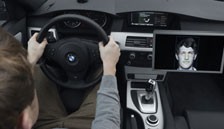New technology will soon allow the company car to ‘refuse’ to be used by unauthorised drivers.
And the same gadgetry will also offer fleet operators the ultimate deterrent against theft, claim researchers at BMW.
Engineers at the premium carmaker’s giant Research and Innovation Centre in Munich are testing a prototype 5 Series saloon that refuses to start unless it recognises the person sitting in the driving seat.
Using next-generation bio-metric equipment, the car takes just a few milliseconds to establish the identity of the person behind the wheel.
If this matches data held in its computer, the engine fires into life and the car immediately begins to adjust the seats, steering, in-car entertainment and even air-conditioning systems according to the driver’s preferences.
Known as Driver Memory, the equipment is based on a small video camera built into the instrument panel.
It snaps into action the moment the car is unlocked and shoots a series of facial pictures focused around the eyes.
“It works so quickly that you don’t realise that anything is happening, but the car will refuse to start unless it comes up with a perfect image match,” said electronics engineer Elmar Weiss.
“We think this application of technology should be of particular benefit in the company car sector because the equipment is able to recognise any number of drivers and remember the ways they like the steering and seats to be adjusted.
“It can even be programmed to remember whether a particular driver likes to have a window down or the sunroof open.”
Development department senior vice-president Elmar Frickenstein added: “We see this equipment as ideal for coping with cases where employees are allowed the occasional use of a management car because it can also be programmed to permit driving but deny access to any of the owner’s private telephone numbers or personal information that might be stored in the on-board computer.”
According to BMW, the Driver Memory technology should not be costly because most of it will operate on the computers used elsewhere in the car.
“The biggest problems we’re facing is reducing both the size and cost of the video camera and making it operate satisfactorily in a car, which usually contains shadows.
"And we’re also still working to get our cameras to distinguish between identical twins,” said Mr Frickenstein.
















Login to comment
Comments
No comments have been made yet.